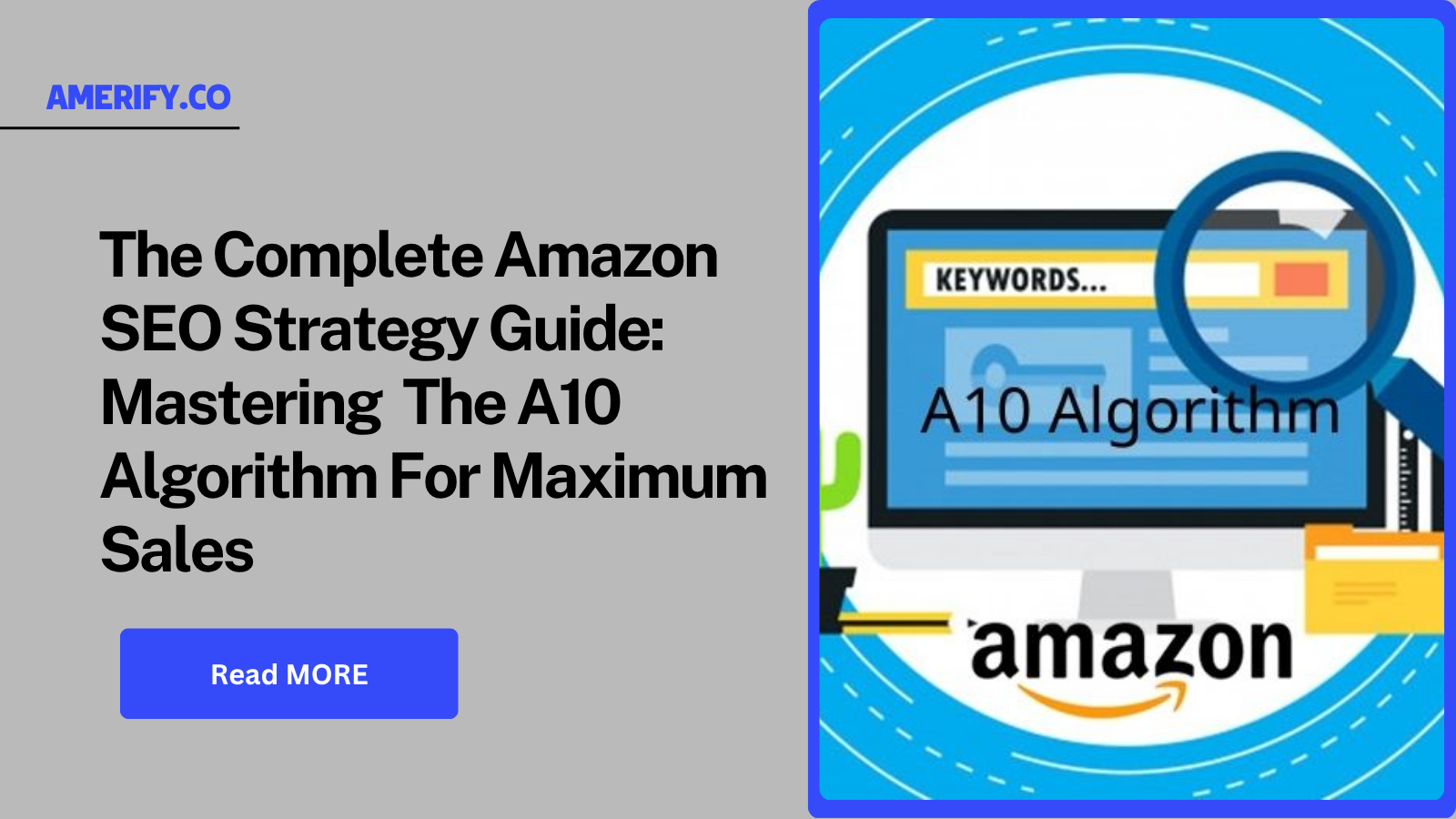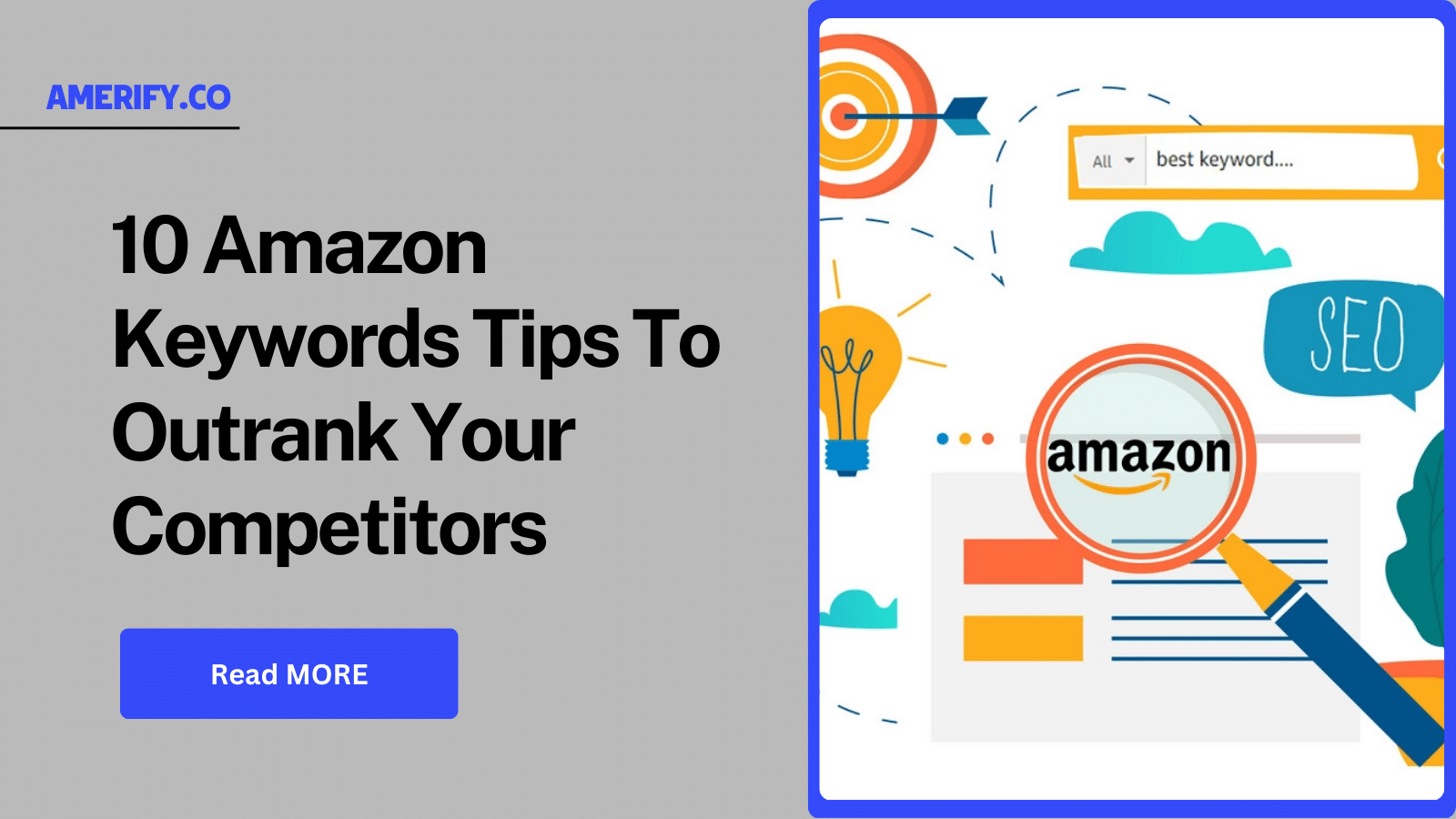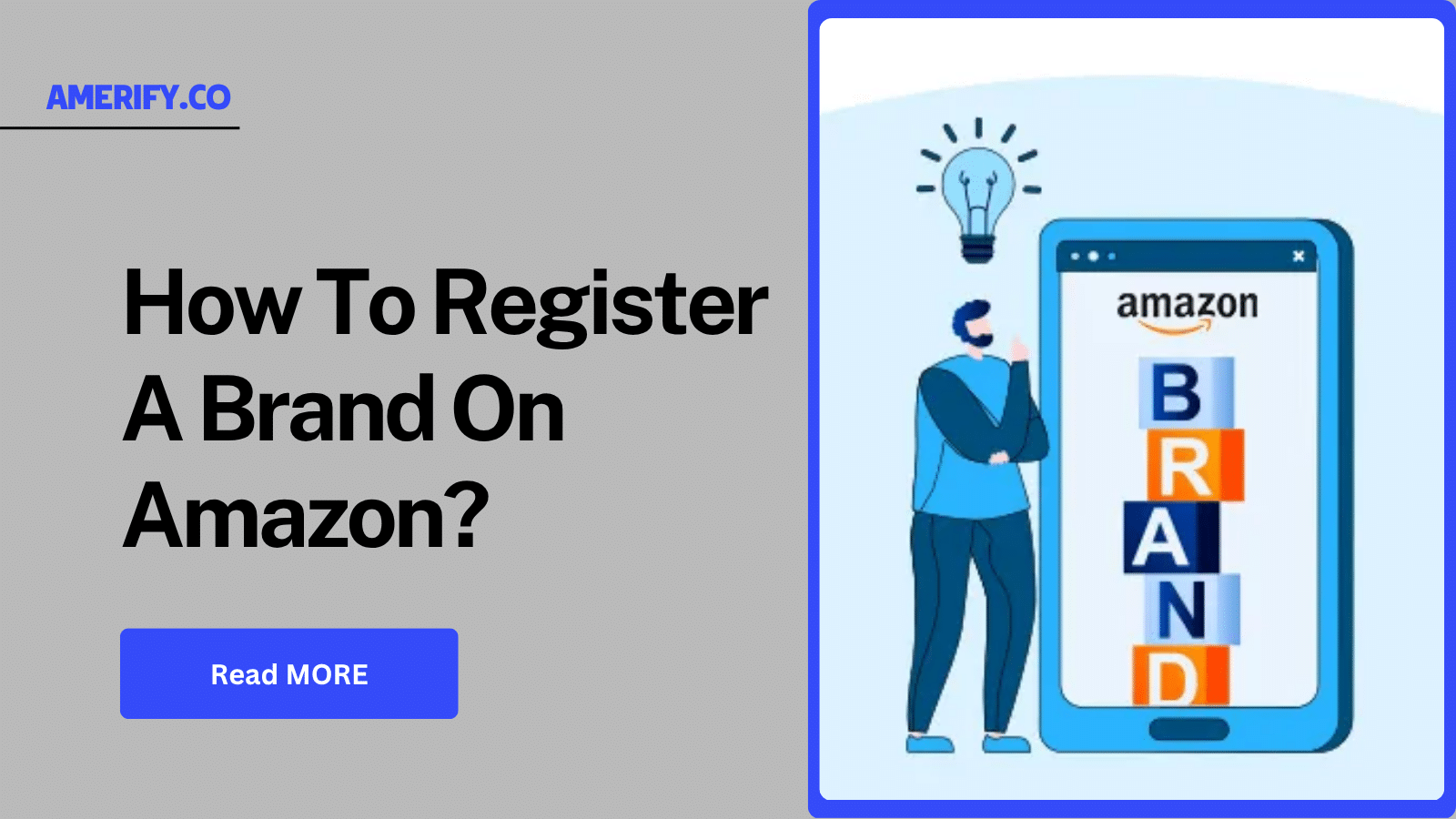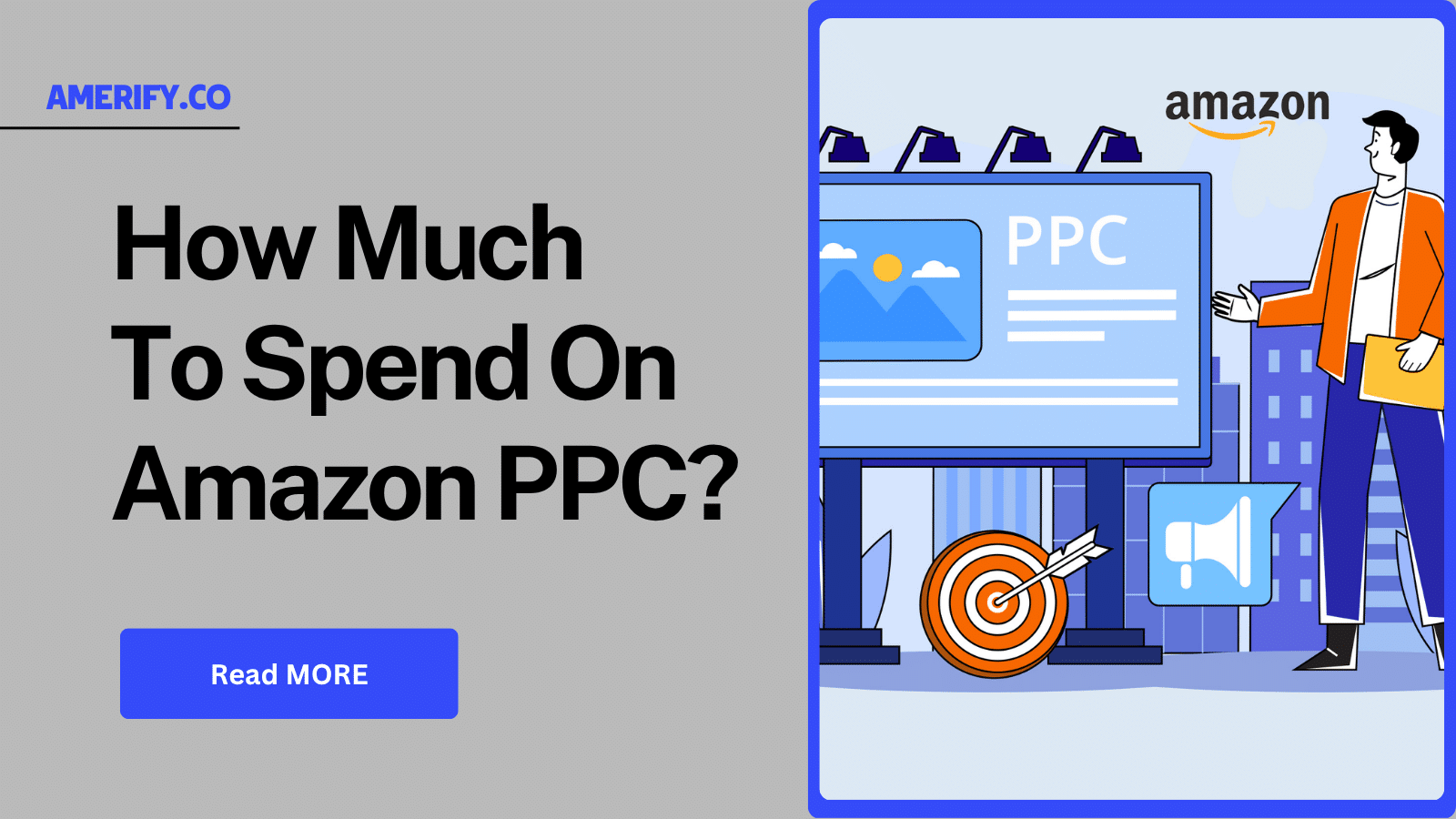Why 99% of Amazon sellers are invisible—and how the top 1% dominate search results
Amazon isn’t just an online marketplace anymore—it’s the world’s largest product search engine. With over 310 million active users conducting billions of product searches monthly, mastering Amazon SEO isn’t optional. It’s survival.
Here’s the brutal truth: 70% of Amazon shoppers never scroll past the first page of results, and the top three organic positions capture 64% of all clicks. Without proper optimization, your products are invisible to potential customers, no matter how amazing they are.
After analyzing thousands of successful Amazon listings and managing over $50 million in Amazon revenue, we’ve cracked the code that separates top-performing products from those lost in the marketplace abyss.
What Top 1% Amazon Sellers Know That You Don’t (Yet)?
- Proven optimization frameworks used by 7-figure Amazon sellers
- Advanced A10 algorithm insights not available elsewhere
- Category-specific strategies for maximum relevance
- Cutting-edge tools and techniques for competitive advantage
The results speak for themselves:
- 200-500% increase in organic visibility
- 25-75% improvement in conversion rates
- Significant boost in search rankings within 30-60 days
- Sustainable competitive advantages that compound over time
Cracking Amazon’s A10 Algorithm: What Changed Everything?
💡 Key Insight: Amazon’s A10 algorithm doesn’t just match keywords—it predicts buyer behavior and rewards products that deliver exceptional customer experiences.
Amazon’s search algorithm evolution from A9 to A10 fundamentally changed how products get discovered. Understanding this shift is crucial for increasing organic sales on Amazon.
A10 vs A9: The Real Shifts Behind Amazon’s Algorithm
The transition represented a seismic shift in search philosophy:
A9 Algorithm (Legacy Approach):
- Primarily keyword-focused matching
- Heavy emphasis on exact match terms
- Limited consideration of user behavior
- Basic relevance scoring systems
A10 Algorithm (Current Reality):
- Machine learning-driven decisions that adapt in real-time
- User intent and behavior analysis across millions of interactions
- Cross-device tracking integration for complete customer journey
- Personalized search results based on individual preferences
- Voice search optimization for Alexa integration
- Brand authority weighting that rewards trust signals
The Four Pillars of A10 Rankings
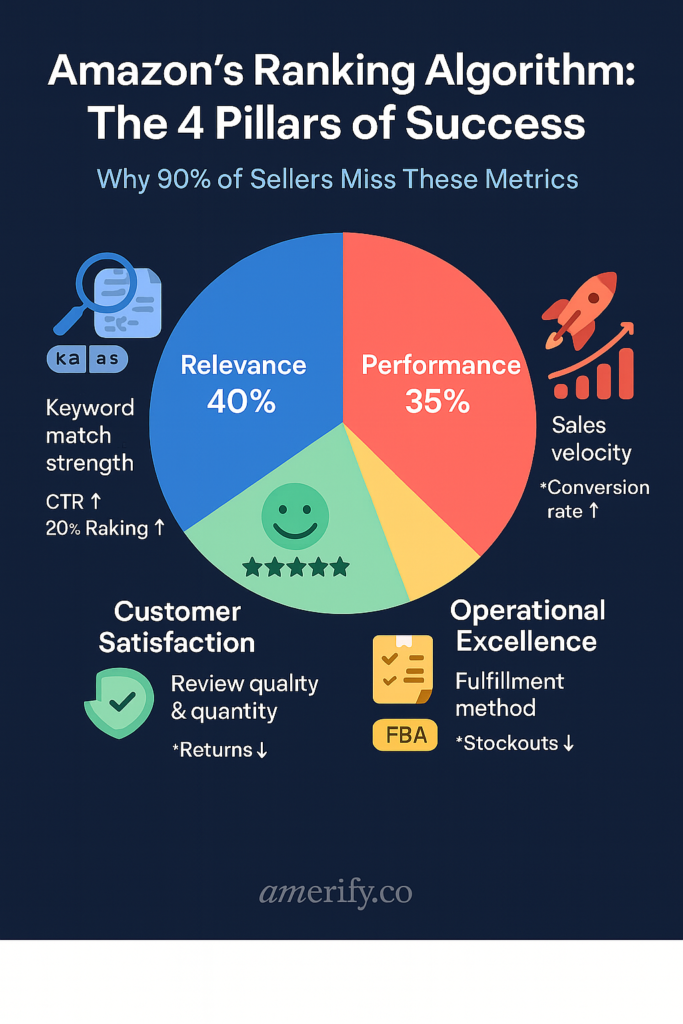
Amazon’s current algorithm weighs ranking factors across four critical areas:
1. Relevance Factors (40% Weight)
- Keyword Match Strength: How well your listing matches search intent
- Category Relevance: Proper categorization and complete attribute data
- Search Term Performance: Historical click-through rates for specific keywords
- Semantic Relevance: Related terms and conceptual matching
2. Performance Factors (35% Weight)
- Sales Velocity: Recent sales performance relative to direct competitors
- Conversion Rate: Percentage of visitors who actually purchase
- Session Duration: Time customers spend engaging with your listing
- Click-Through Rate: Percentage of searchers who choose your product
3. Customer Satisfaction (15% Weight)
- Review Quality and Quantity: Average rating weighted by review volume
- Return Rate: Percentage of products returned or refunded
- Customer Service Metrics: Response time and resolution effectiveness
- Q&A Engagement: Quality of customer questions and seller responses
4. Operational Excellence (10% Weight)
- Fulfillment Method: FBA vs. FBM performance metrics
- Inventory Levels: Consistent stock availability
- Shipping Performance: Delivery speed and reliability tracking
Choose amerify and experience the difference our experts can make.
How A10 Processes Search Queries?
When a customer enters a search term, A10 follows this process:
- Query Analysis: Understanding search intent and user context
- Candidate Selection: Identifying potentially relevant products
- Relevance Scoring: Calculating match strength for each product
- Performance Weighting: Applying historical performance data
- Personalization: Adjusting results based on user history
- Final Ranking: Determining the order of search results
The Personalization Factor
A10’s personalization capabilities significantly impact search results:
- Purchase History: Previous buying patterns influence product visibility
- Browsing Behavior: Recently viewed categories and products
- Geographic Location: Local preferences and shipping considerations
- Device Usage: Mobile vs. desktop optimization factors
- Time-Based Patterns: Seasonal and temporal buying behaviors
The Three-Pillar Framework for Amazon SEO Domination (How To Rank for Keywords on Amazon?)
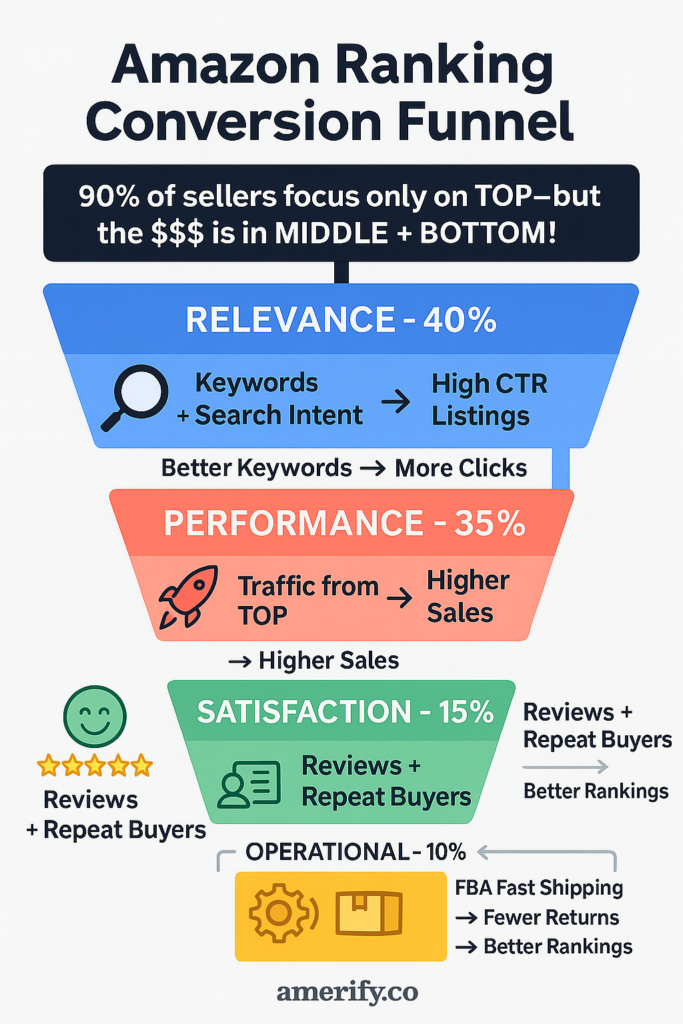
Success on Amazon requires mastering three interconnected elements that work together to drive rankings and sales.
Pillar 1: Discoverability – Getting Found in the First Place
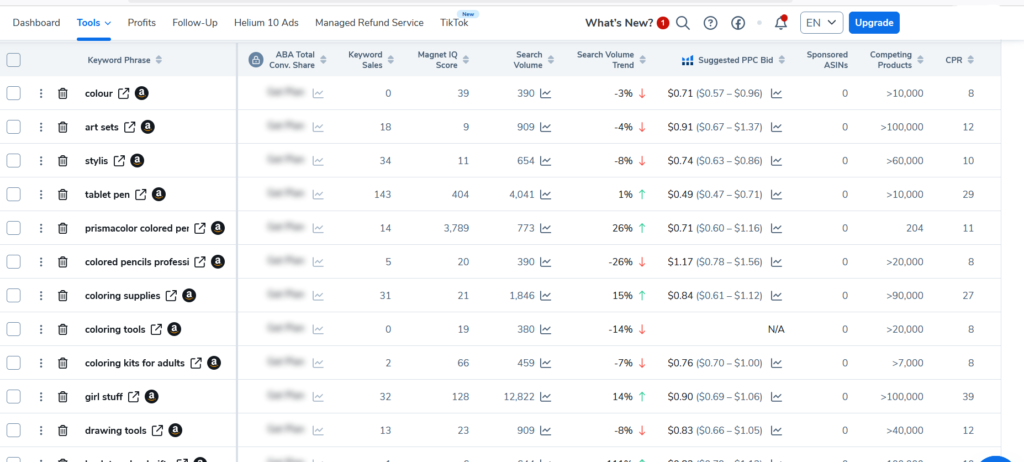
Discoverability is about visibility—ensuring your products appear when customers search for solutions you provide.
Core Components:
- Strategic Keyword Research: Identifying high-volume, low-competition terms that actual customers use
- Search Term Optimization: Strategic placement across all listing elements for maximum algorithm recognition
- Category Selection: Proper categorization that maximizes exposure opportunities
- Browse Node Optimization: Leveraging Amazon’s internal categorization system
Advanced Discoverability Tactics:
- Long-tail Keyword Targeting: Capturing specific, high-intent searches that convert better
- Seasonal Keyword Adaptation: Adjusting terms based on temporal buying patterns
- Competitor Gap Analysis: Finding profitable keywords your competitors miss
- Voice Search Optimization: Preparing for increased Alexa integration
Pillar 2: Relevance – Matching Customer Intent Perfectly
Relevance measures how well your product matches what customers actually want when they search.
Key Components:
- Title Optimization: Balancing keyword optimization with human readability
- Feature Highlighting: Emphasizing product attributes that matter most
- Use Case Specification: Clearly defining when and how your product solves problems
- Target Audience Alignment: Matching specific customer demographics and needs
Advanced Relevance Strategies:
- Semantic Keyword Integration: Using related terms and natural synonyms
- Intent-Based Optimization: Matching specific customer problem-solving needs
- Competitive Differentiation: Highlighting unique value propositions clearly
- Cross-Reference Optimization: Connecting with complementary products and categories
🎯 Pro Tip: “The best listings don’t just match keywords—they anticipate and answer the questions customers haven’t even asked yet.”
Pillar 3: Conversion – Turning Browsers into Buyers
Conversion optimization focuses on persuading customers to purchase once they find your listing.
Essential Elements:
- Visual Appeal: High-quality, informative product images that sell
- Social Proof: Customer reviews and ratings optimization strategies
- Value Communication: Clear, compelling benefit presentation
- Trust Building: Professional presentation and credibility signals
Advanced Conversion Tactics:
- Psychological Triggers: Strategic use of scarcity, urgency, and social proof
- Mobile Optimization: Ensuring seamless mobile-first user experience
- A/B Testing Systems: Continuous optimization through systematic experimentation
- Customer Journey Mapping: Understanding and optimizing every touchpoint
A Full-Stack Amazon SEO Framework
A. Keyword Research: The Foundation of Amazon SEO Success
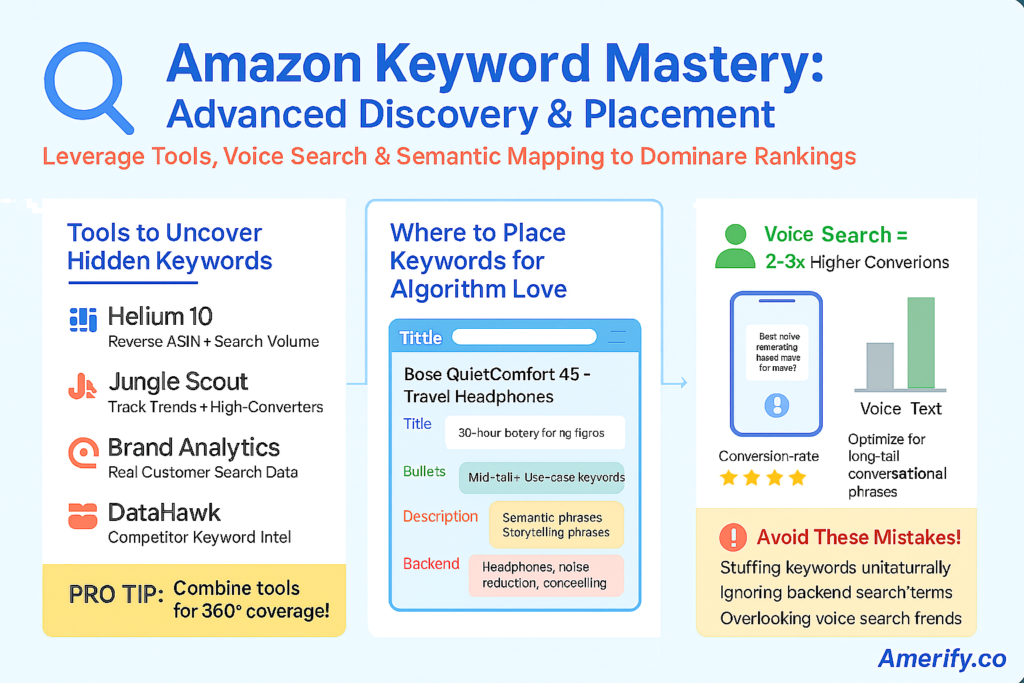
Keyword research is no longer just about volume — it’s about relevance, intent, and contextual integration when looking for answer to how to increase organic sales on Amazon
As the A10 algorithm evolves, success depends on using keywords not just to get found, but to get clicked and converted.
Step 1: Strategic Discovery with Advanced Tools
Use a combination of tools to uncover keyword opportunities from multiple angles:
- Helium 10 (Cerebro & Magnet): Reverse ASIN analysis, search volume, keyword difficulty, and competitor overlap.
- Jungle Scout: High-converting keyword tracking, historical trends, and opportunity scores.
- DataHawk: Organic keyword visibility and competitive benchmarking.
- Amazon Brand Analytics: Customer search term report to identify actual buyer behavior.
These tools help you go beyond surface-level keywords to find the language your ideal customers actually use.
Step 2: The Layered Keyword Approach
Your keyword list should be organized into four tactical tiers, each mapped to specific listing components.

Voice Search Terms like “what are the best noise cancelling headphones for travel” are increasingly important due to Alexa and mobile voice commands. These often become long-tail keywords with high conversion intent.
📊 Data Point: Voice search terms typically have 2-3x higher conversion rates than traditional text searches due to their specificity and intent clarity.
Step 3: Semantic Mapping for Maximum Relevance
Once your keyword tiers are established, map them intentionally across your listing content:
- Title: Use 1–2 primary keywords in the first 80 characters. Avoid keyword stuffing — clarity wins clicks.
- Bullet Points: Weave in secondary and mid-tail keywords naturally, focusing on benefits first.
- Product Description: Ideal for semantic phrases and use-case language. This is where storytelling meets search optimization.
- Image Alt Text (A+ content): While Amazon doesn’t use traditional image alt tags for SEO, accessibility best practices and Google indexing still favor keyword-aligned alt text.
- Backend Search Terms: This is where you use synonyms, misspellings, competitor names (if compliant), and overflow terms that didn’t fit naturally on the front end.
Step 4: Conversion-Based Keyword Filtering
High-volume keywords don’t matter if they don’t convert.
Use:
- Search Term Reports from PPC campaigns to evaluate which keywords actually lead to sales.
- A/B testing to experiment with keyword placement.
- Helium 10’s Keyword Tracker to monitor rankings and refine usage over time.
Pro Tip: Build a Keyword Map Template
Maintain a master spreadsheet that maps:
- Each keyword to its intended purpose and location (Title, Bullet 1, Backend Field 2, etc.)
- Match type (Exact, Phrase, Broad)
- Relevance score (1–10 based on conversion data or customer alignment)
This becomes your keyword architecture blueprint — scalable, repeatable, and trackable.
B. Product Title Optimization: Your 80-Character Sales Pitch
Your product title is the most critical element for both search visibility and customer attraction. It carries the highest SEO weight and often determines whether customers click on your listing.
1. Title Optimization Framework: The SPARK Formula
S – Specific Product Type
P – Primary Keyword
A – Attributes (size, color, material)
R – Relevant Features
K – Keywords (secondary)
Character Limits by Platform
| Platform | Character Limit | Optimal Range |
| Desktop Search | 200 characters | 150-180 |
| Mobile Search | 78 characters | 60-75 |
| Sponsored Ads | 150 characters | 120-140 |
2. Title Construction Strategy
If you analyze the results from the screenshots below, you can clearly see that there are different locations where a listing can show up.
So, the placement of keywords within the title definitely needs attention if you want your listing to be visible at all the possible locations.
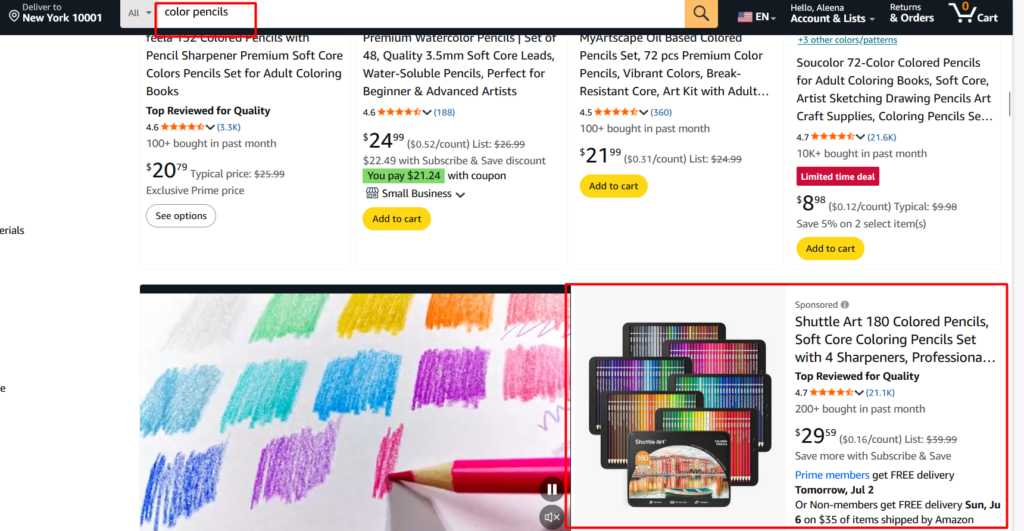
a. Keyword Priority Placement
Place your most important keywords within the first 80 characters to ensure visibility across all platforms.
Example Structure: [Brand] [Primary Keyword] [Key Attribute] [Secondary Keyword] – [Unique Feature] [Size/Color]
b. Natural Language Integration
Avoid keyword stuffing while maintaining search optimization:
Poor Example: Phone Case iPhone 13 Case Clear Case Protective Case Drop Proof Case
Optimized Example: OTTERBOX iPhone 13 Clear Case – Ultra-Slim Protective Cover with Drop Protection
c. Brand Positioning Strategy
- New Brands: Lead with primary keyword, follow with brand
- Established Brands: Lead with brand name for recognition
3. Category-Specific Title Optimization
Electronics: Include model numbers, compatibility details, and relevant certifications like FCC or CE.
Clothing & Accessories: Mention material composition (cotton, polyester), fit (regular, slim, plus-size), and style descriptors (casual, athletic, formal).
Home & Garden: Include room-specific context (bathroom, patio), materials and durability (stainless steel, weather-resistant), and style cues (modern, rustic).
Health & Beauty: Mention applicable skin types, organic or hypoallergenic certifications, and target demographics such as age groups.
Common Title Mistakes to Avoid
- Keyword Stuffing: Unnatural keyword repetition
- Excessive Capitalization: Using ALL CAPS inappropriately
- Special Characters: Overusing symbols and punctuation
- Irrelevant Information: Including non-essential details
- Brand Repetition: Repeating brand name multiple times
- Generic Descriptions: Using vague, non-specific terms
C. Bullet Points: Your Silent Sales Force
Bullet points serve as your sales pitch, highlighting key features and benefits that convince customers to purchase.
While they don’t directly impact search rankings, they significantly influence conversion rates, which indirectly affects SEO performance.
The Psychology of Bullet Points
Customers scan bullet points to quickly assess product value. Research shows that:
- 73% of customers read all bullet points before purchasing
- Well-optimized bullets can increase conversion rates by 25-40%
- Benefit-focused bullets outperform feature-focused ones by 60%
The BENEFIT Framework
B – Benefit Statement
E – Evidence/Proof
N – Need Addressed
E – Emotional Appeal
F – Feature Description
I – Implementation/Usage
T – Trust Elements
Bullet Point Optimization Strategy
1. The 5-Point Structure
- Bullet 1: Primary benefit and main use case
- Bullet 2: Quality/durability features
- Bullet 3: Convenience/ease of use
- Bullet 4: Unique differentiators
- Bullet 5: Guarantee/warranty information
2. Benefit-First Approach
Start each bullet with the customer benefit, then support with features:
- Feature-Focused (Weak): Made with premium stainless steel construction
- Benefit-Focused (Strong): LONG-LASTING DURABILITY – Premium stainless steel construction resists rust and corrosion, ensuring years of reliable performance
3. Keyword Integration Strategy
Naturally incorporate secondary keywords that didn’t fit in the title:
- Use keyword variations and synonyms
- Include long-tail search terms
- Add related product terminology
- Integrate use-case specific language
Common Bullet Point Mistakes
- Feature Dumping: Listing features without explaining benefits
- Keyword Stuffing: Unnaturally forcing keywords
- Inconsistent Formatting: Poor visual presentation
- Generic Language: Using vague, non-specific terms
- No Proof Points: Making claims without support
- Ignoring Mobile: Not considering mobile display
D. Product Description: Your Brand Authority Builder
The product description offers expanded space to build brand authority, provide detailed information, and incorporate additional keywords for improved search visibility.
Description vs. Enhanced Brand Content (A+)
Standard Product Description:
- 2,000 character limit
- Basic HTML formatting
- Available to all sellers
- Text-only content
Enhanced Brand Content (A+):
- Brand registered sellers only
- Rich media capabilities
- Brand story integration
- Comparison charts and premium visuals
Product Description Optimization Framework: The STORY Method
S – Situation/Problem
T – Task/Solution
O – Outcome/Benefits
R – Results/Proof
Y – Your Call-to-Action
Content Structure Strategy
1. Opening Hook (First 100 characters)
Create immediate engagement:
- Ask a compelling question
- State a surprising statistic
- Present a bold benefit claim
- Address a common frustration
Example: Transform your daily routine with professional-grade results at home. Discover why over 50,000 customers trust our innovative solution…
2. Problem-Solution Narrative
Develop a story that resonates:
- Identify the pain point
- Amplify the consequence
- Introduce your solution
- Explain the mechanism
- Demonstrate the outcome
3. Feature-Benefit Translation
Convert technical features into customer benefits:
| Feature | Customer Benefit |
| “Waterproof to 50 meters” | “Use confidently in any weather – rain, snow, or shine” |
| “Dual-core processor” | “Lightning-fast performance that saves you time” |
| “Antimicrobial coating” | “Stays fresh and hygienic with natural protection” |
Advanced Description Techniques
1. Storytelling Integration
Create emotional connections through narrative:
- Origin Story: How the product was developed
- Customer Journey: Typical user experience
- Transformation Story: Before and after scenarios
- Brand Mission: Company values and purpose
2. Scientific Credibility
Build trust through evidence:
- Research Citations: Studies supporting claims
- Expert Endorsements: Professional recommendations
- Certification Mentions: Industry standards met
- Testing Results: Performance data
3. Use Case Expansion
Demonstrate versatility:
- Multiple application scenarios
- Different user types and needs
- Seasonal usage variations
- Professional vs. personal applications
HTML Formatting for Enhanced Presentation
Basic HTML Tags for Amazon:
- <b>Bold Text</b> – For emphasis and key points
- <i>Italic Text</i> – For subtle emphasis
- <br> – Line breaks for readability
- <p>Paragraph separation</p> – Content organization
Advanced Formatting Techniques:
- Bullet Lists: Organize information clearly
- Subheadings: Create scannable content
- Spacing: Improve visual appeal
- Emphasis: Highlight key benefits
Mobile-First Optimization: The New Reality
Most customers shop on their phones. The mobile optimization essentials:
- Keep paragraphs to 2-3 sentences maximum
- Front-load key benefits in the first few lines
- Use scannable formatting with clear visual breaks
- Structure information logically for quick consumption
Think of your product description as texting a friend who’s in a hurry. Your opening needs to hook them immediately, then guide their eyes naturally down the page.
E. Backend Search Terms: Hidden SEO Gold
While competitors obsess over visible keywords, smart sellers know the real magic happens behind the scenes.
Backend search terms are your secret conversation with Amazon’s algorithm—and most sellers are completely missing this opportunity.
The COMPREHENSIVE Method
C – Competitor Keywords
O – Omitted Terms (from front-end)
M – Misspellings and Variations
P – Plurals and Singulars
R – Related Products
E – Emotional Descriptors
H – Historical/Seasonal Terms
E – Exact Customer Language
N – Niche Terminology
S – Synonyms
I – International Variations
V – Voice Search Terms
E – Emerging Trends
Understanding the Backend System
- You get 5 search term fields, 50 bytes each
- Total of 249 bytes (not characters!) available
- Amazon counts bytes, so special characters eat up space quickly
- These terms are invisible to customers but crucial for rankings
What to Include in Backend Terms?
1. Keyword Variations Not in Front-End
Terms that didn’t fit naturally in title, bullets, or description:
- Alternative product names
- Industry-specific terminology
- Regional language differences
- Abbreviated forms
2. Misspellings and Typos
Common customer misspellings:
- Letter transpositions
- Missing letters
- Extra letters
- Phonetic spellings
Example for “Bluetooth”: bluetooth, blutooth, blue tooth, bluetoth, bluetooth
3. Long-Tail Search Phrases
Specific, high-intent searches:
- “best [product] for [specific use]”
- “[product] that [specific function]”
- “affordable [product] with [feature]”
4. Competitor Brand Names
Controversial but Legal Strategy:
- Include competitor brand names
- Focus on compatibility terms
- Use “compatible with” or “alternative to”
- Avoid trademark infringement
5. Seasonal and Occasion Keywords
Time-sensitive search terms:
- Holiday-related terms
- Seasonal applications
- Event-specific usage
- Gift-giving occasions
Advanced Backend Strategies
1. Customer Language Mining
Extract terms from:
- Customer Reviews: Actual language used
- Q&A Sections: Questions customers ask
- Social Media: Informal product references
- Support Tickets: Problem descriptions
2. International Market Terms
Include variations for global customers:
- British vs. American English: “colour” vs. “color”
- Regional Terminology: Local product names
- Cultural References: Culturally specific terms
- Translation Variations: Different English translations
3. Voice Search Optimization
Prepare for Alexa integration:
- Conversational Phrases: Natural speech patterns
- Question-Based Terms: “What is the best…”
- Local Dialect: Regional speech variations
- Command Phrases: Action-oriented terms
Common Backend Mistakes
- Keyword Repetition: Using same terms multiple times
- Character Waste: Inefficient space usage
- Irrelevant Terms: Including unrelated keywords
- Punctuation Errors: Using unnecessary characters
- Brand Violations: Trademark infringement
- Byte Miscounting: Exceeding actual limits
F. Image Optimization: Visual SEO That Sells
Amazon is becoming increasingly visual, with images playing a crucial role in both search rankings and conversion rates.
High-quality, optimized images can significantly impact your product’s performance.
The 9-Image Strategy Framework
Image 1: Main Product Photo
- Clean white background
- Product centered and well-lit
- Shows entire product clearly
- Professional photography quality
Image 2: Lifestyle/In-Use Photo
- Product being used naturally
- Demonstrates scale and context
- Shows target customer demographic
- Creates emotional connection
Image 3: Feature Callouts
- Highlights key features
- Uses text overlays and arrows
- Explains unique benefits
- Technical specifications
Image 4: Size/Scale Demonstration
- Shows product dimensions
- Includes size comparisons
- Demonstrates portability
- Clarifies customer expectations
Image 5: What’s Included
- Unboxing or kit layout
- Shows all components
- Reduces customer confusion
- Sets proper expectations
Image 6: Quality Details
- Close-up material shots
- Craftsmanship highlights
- Durability demonstrations
- Premium quality indicators
Image 7: Comparison Chart
- Competitor comparisons
- Feature matrices
- Value propositions
- Decision-making aids
Image 8: Guarantee/Warranty
- Trust-building elements
- Certification badges
- Warranty information
- Customer service details
Image 9: Brand Story
- Company information
- Brand values
- Manufacturing process
- Social responsibility
G. Pricing Strategy for SEO Success
Pricing significantly impacts Amazon SEO performance through its direct influence on conversion rates, sales velocity, and competitive positioning. Strategic pricing can improve search rankings while maximizing profitability.
The Price-SEO Connection
How Pricing Affects Amazon SEO?
- Conversion Rate: Optimal pricing increases purchase likelihood
- Sales Velocity: Competitive pricing drives higher sales volume
- Buy Box Eligibility: Price competitiveness affects featured placement
- Customer Satisfaction: Fair pricing reduces negative reviews
- Market Positioning: Premium vs. budget segment targeting
- Competitive Advantage: Price-based differentiation
- Inventory Turnover: Pricing affects stock movement
- Profit Margins: Sustainable pricing for long-term growth
Dynamic Pricing Strategies
1. Competitive Pricing Analysis
Market Research Framework:
- Direct Competitors: Same product, similar features
- Indirect Competitors: Alternative solutions
- Price Elasticity: Customer sensitivity testing
- Market Positioning: Premium, mid-tier, or budget
Tools for Competitive Analysis:
- Keepa: Historical pricing data
- CamelCamelCamel: Price tracking
- Jungle Scout: Market intelligence
- RepricerExpress: Automated repricing
2. Psychological Pricing Techniques
Charm Pricing ($9.99 vs $10.00):
- 30% higher conversion rates
- Perceived value enhancement
- Category-dependent effectiveness
- Cultural considerations for international markets
Bundle Pricing Strategy:
- Higher average order value
- Improved inventory management
- Enhanced customer satisfaction
- Competitive differentiation
Tiered Pricing Options:
- Good-Better-Best positioning
- Customer segmentation
- Upselling opportunities
- Market coverage expansion
The Sweet Spot Formula
Optimal Price = (Customer Value Perception) – (Competitive Pressure) + (Unique Value Proposition)
📈 Performance Data: Products priced within 5-10% of market leaders while offering superior value propositions see 40% higher conversion rates than premium-priced alternatives.
Promotional Pricing for SEO Boost
Lightning Deal Benefits:
- Increased Visibility: Featured placement
- Sales Velocity Boost: Temporary ranking improvement
- Inventory Movement: Stock clearance
- Customer Acquisition: New buyer attraction
Coupon Strategy:
- Percentage vs. Dollar Amount: Psychological impact
- Minimum Purchase Requirements: AOV improvement
- Time-Limited Offers: Urgency creation
- Targeted Promotions: Customer segment focus
H. Amazon PPC Integration with SEO
Amazon PPC (Pay-Per-Click) advertising and SEO work synergistically to maximize product visibility and sales.
Strategic integration of paid and organic efforts amplifies overall performance.
The SEO-PPC Synergy
Keyword Discovery:
- Search Term Reports: Identify high-performing keywords
- Conversion Data: Understand which terms drive sales
- Negative Keywords: Refine targeting precision
- Long-tail Opportunities: Discover niche search terms
Performance Validation:
- Ranking Acceleration: PPC drives initial sales velocity
- Conversion Testing: Validate keyword effectiveness
- Market Response: Gauge customer demand
- Competitive Intelligence: Understand market dynamics
Quality Score Improvement:
- Relevant Listings: Better ad-to-product alignment
- Higher CTR: Optimized listings increase click-through rates
- Lower ACoS: Improved conversion rates reduce advertising costs
- Better Positioning: Strong organic presence supports paid efforts
Strategic PPC Campaign Structure For Different Categories
Sponsored Products:
- Auto Campaigns: Keyword discovery and broad reach
- Manual Campaigns: Targeted keyword optimization
- Product Targeting: Competitor and category targeting
- Exact Match: High-intent keyword capture
Sponsored Brands:
- Brand Awareness: Company visibility enhancement
- Category Domination: Market presence expansion
- Customer Journey: Multiple touchpoint strategy
- Brand Defense: Competitive protection
Sponsored Display:
- Retargeting: Customer re-engagement
- Lookalike Audiences: Similar customer targeting
- Product Targeting: Cross-selling opportunities
- Brand Building: Awareness and consideration
The Keyword Funnel Approach
Discovery Phase (Auto Campaigns)
- Broad Keyword Discovery: Wide net approach
- Performance Analysis: Identify winners and losers
- Negative Keyword Development: Refine targeting
- Budget Allocation: Focus resources on performers
Optimization Phase (Manual Campaigns)
- Exact Match Campaigns: High-intent keyword targeting
- Phrase Match Campaigns: Moderate intent targeting
- Broad Match Campaigns: Discovery and expansion
- Product Targeting: Competitor and category focus
Refinement Phase (Ongoing)
- Bid Optimization: Performance-based adjustments
- Negative Keyword Expansion: Waste elimination
- Ad Copy Testing: Creative optimization
- Landing Page Optimization: Conversion improvement
I. External Traffic & Its SEO Impact
Amazon’s A10 algorithm increasingly favors listings that attract traffic from outside its own ecosystem. This signals strong brand authority, market demand, and buyer intent — all of which enhance your organic rankings, conversion rates, and long-term SEO equity.
Driving high-quality external traffic is no longer optional — it’s a differentiator Amazon rewards with better visibility and Buy Box preference.
Why External Traffic Matters for Amazon SEO?
- Boosts Sales Velocity: A surge in external traffic can increase order volume rapidly, triggering a positive feedback loop for organic ranking.
- Increases Relevance Signals: If off-Amazon shoppers consistently purchase your product after clicking through, Amazon perceives your listing as highly relevant.
- Diversifies Traffic Sources: Reduces dependency on Amazon’s own ad ecosystem, giving you greater control over buyer acquisition costs.
- Builds Brand Authority: External engagement (clicks, shares, backlinks) adds signals that Amazon correlates with trust and quality — much like Google does.
Top Channels to Drive External Traffic
Social Media Campaigns
- Facebook & Instagram Ads: Use retargeting and interest-based audiences to promote Amazon listings directly with custom URLs.
- TikTok UGC (User-Generated Content): Organic, native-style videos that showcase your product in use can go viral and send warm traffic directly to your listing.
- Pinterest Pins: Especially valuable for lifestyle, home, beauty, and DIY products. Optimized pins often stay visible for months.
Tip: Always use Amazon Attribution tags to track performance by platform.
Google SEO: Content-Driven Inbound Strategy
- Create blog posts, buyer guides, and product comparison pages that target search terms like:
- “Best [product] on Amazon”
- “Top-rated [category item] for [use case]”
- “Best [product] on Amazon”
- Include embedded Amazon links and CTAs.
- Build backlinks to these pages to enhance authority.
Why this works:
- Google brings in high-intent organic traffic
- Visitors already searching for product categories
- Amazon listings linked from well-ranking content get click-through trust
Affiliate Partnerships
- Partner with influencers, reviewers, and publishers in your niche.
- Get listed in gift guides, product roundups, or tutorial content.
- Use Amazon Associates to give partners a commission incentive.
This builds:
- Social trust: Third-party validation enhances credibility
- Conversion intent: Influencer audiences are warmer than cold PPC traffic
Traffic velocity: Helps sustain momentum during launches or seasonal pushes
Email Campaigns (for Brand Registered Sellers)
- Use email to drive repeat buyers back to Amazon for:
- New product launches
- Limited-time promotions
- Lightning deals or coupons
- New product launches
- For those with DTC stores or email lists from past off-Amazon sales, email traffic is a cost-effective and conversion-strong channel.
- Strategy: Time email blasts with Amazon deals for max ROI and improved sales velocity.
Tracking External Traffic Performance
Use Amazon Attribution to measure which external sources are contributing to:
- Clicks
- Add-to-carts
- Sales
- Conversion rate
Also implement UTM parameters and Google Analytics for traffic from blogs, email campaigns, or paid ads.
You can then:
- Allocate more budget to high-converting sources
- Refine messaging by platform
- Understand the full funnel from click to conversion
Advanced Tip: Build a Retargeting Loop
- Drive external traffic to a landing page with a “Buy on Amazon” button
- Pixel this traffic using Facebook/Google/TikTok tags
- Run retargeting ads to those who didn’t convert
- Use Amazon Attribution to connect off-Amazon behavior to Amazon sales
This gives you precise visibility into buyer behavior while boosting Amazon SEO through external engagement and re-engagement.
J. Review Strategy and Management
Customer reviews are crucial for both Amazon SEO and conversion optimization. They serve as social proof, influence search rankings, and directly impact purchase decisions.
The Review Ecosystem Impact
Direct Ranking Factors:
- Review Velocity: Rate of new review acquisition
- Overall Rating: Average star rating impact
- Review Recency: Fresh review timeline
- Review Volume: Total number of reviews
Indirect SEO Benefits:
- Conversion Rate: Higher ratings improve purchases
- Click-Through Rate: Better ratings increase clicks
- Customer Confidence: Social proof reduces bounce
- Long-tail Keywords: Reviews contain search terms
Strategic Review Acquisition
Automated Follow-up Sequences:
- Post-Purchase Emails: Timely review requests
- Delivery Confirmation: Satisfaction check-ins
- Usage Follow-up: Experience-based requests
- Problem Resolution: Service recovery opportunities
Product Insert Strategy:
- Thank You Cards: Personal touch appreciation
- QR Code Access: Easy review submission
- Bonus Incentives: Additional value provision
- Brand Story: Connection building
Review Response Strategy
Positive Review Responses:
- Gratitude Expression: Sincere appreciation
- Feature Reinforcement: Highlight mentioned benefits
- Community Building: Encourage continued engagement
- Brand Personality: Consistent voice maintenance
Negative Review Management:
- Prompt Response: Quick acknowledgment
- Problem Resolution: Solution-focused approach
- Public Transparency: Open communication
- Private Follow-up: Direct customer contact
Review Analytics and Optimization
Key Performance Indicators
Quantitative Metrics:
- Review Acquisition Rate: Reviews per sale percentage
- Average Rating Trends: Rating trajectory analysis
- Review Velocity: New review frequency
- Response Rate: Customer engagement levels
Qualitative Analysis:
- Sentiment Analysis: Emotional tone assessment
- Feature Mentions: Product attribute feedback
- Competitor Comparisons: Market positioning insights
- Improvement Opportunities: Product enhancement areas
Review Mining for SEO
Keyword Extraction:
- Customer Language: Natural search term usage
- Product Descriptions: Alternative naming conventions
- Use Case Identification: Application scenarios
- Pain Point Discovery: Problem-solution matching
Implementation Strategy:
- Backend Keyword Updates: Review-derived terms
- Listing Optimization: Customer language integration
- Content Development: Review-inspired copy
- Product Development: Feature enhancement priorities
K. Performance Metrics and Tracking
Comprehensive performance tracking forms the foundation of successful Amazon SEO, providing the data necessary to measure success, identify opportunities, and guide optimization decisions. Without proper metrics, even the most sophisticated SEO strategies operate blindly.
Essential Amazon SEO Metrics
The most critical performance indicators fall into several key categories. Search ranking metrics provide the clearest picture of SEO effectiveness, with Best Seller Rank (BSR) offering category position insights, keyword rankings showing target term performance, and featured placement tracking Buy Box and sponsored positions. These metrics directly correlate with visibility and sales potential.
Traffic and engagement metrics reveal how well listings capture and retain customer attention. Session percentage indicates traffic share capture relative to competitors, while page views and session duration measure the quality of engagement. Bounce rate serves as a crucial indicator of listing relevance, with high bounce rates suggesting misalignment between search intent and product presentation.
Conversion metrics ultimately determine SEO success in terms of business impact. Unit session percentage represents the conversion rate, while add-to-cart rate indicates purchase intent. Buy Box percentage shows featured offer share, and revenue per visitor measures monetization efficiency across all traffic sources.
Secondary performance indicators provide broader context for SEO efforts. Brand search volume indicates growing brand awareness, while market share measurements reveal category dominance. Customer lifetime value metrics help assess long-term success beyond immediate conversions.
Tracking Infrastructure Setup
Building effective tracking infrastructure requires combining Amazon’s native analytics with third-party solutions. Amazon Seller Central reports provide built-in performance data, while Brand Analytics offers keyword and competitor insights. The Advertising Console delivers PPC performance metrics, and A+ Content Analytics tracks enhanced content performance.
Third-party tracking solutions like Helium 10, Jungle Scout, and Sellics provide comprehensive SEO tracking capabilities that extend beyond Amazon’s native tools. These platforms offer unified analytics dashboards, market intelligence, and competitive tracking features that provide deeper insights into performance drivers.
Custom dashboard creation enables real-time monitoring of key performance indicators. Effective dashboards include current ranking positions, traffic trend analysis, conversion funnel optimization, and competitive benchmarks. Automated reporting systems generate daily snapshots, weekly trend analysis, monthly strategic reviews, and quarterly planning insights.
Advanced Analytics Techniques
Cohort analysis provides powerful insights into customer behavior patterns and SEO impact. By tracking acquisition cohorts based on traffic sources, behavioral cohorts based on actions taken, and value cohorts based on revenue generated, sellers can understand how different SEO strategies affect customer segments over time.
Attribution modeling helps determine which SEO efforts drive the most valuable results. Multi-touch attribution tracks customer journeys from first discovery through final conversion, while cross-channel analysis reveals how SEO efforts interact with PPC, social media, and email marketing to drive overall performance.
Competitive Intelligence Tracking
Market position monitoring provides essential context for SEO performance. Tracking relative rankings, share of voice, pricing dynamics, and feature comparisons helps identify competitive advantages and market opportunities. Automated competitor tracking systems monitor ranking changes, price movements, inventory levels, and review patterns to provide real-time competitive intelligence.
Understanding market trends through category growth analysis, seasonal patterns, and emerging competitor identification enables proactive SEO strategy adjustment. This intelligence helps sellers stay ahead of market changes rather than simply reacting to them.
ROI Measurement and Attribution
Financial performance tracking ensures SEO efforts deliver measurable business value. Revenue attribution analysis separates organic revenue from paid traffic, measures incremental revenue from optimization efforts, and calculates customer lifetime value improvements. Cost analysis includes SEO investment resources, opportunity costs, and technology tool investments to determine true ROI.
Long-term value assessment focuses on brand building metrics including awareness development, equity creation, and market position strengthening. Sustainable growth indicators track organic expansion, market share gains, operational efficiency improvements, and innovation pipeline development.
Advanced Amazon SEO Tactics
Advanced Amazon SEO tactics go beyond basic optimization to leverage sophisticated strategies that create sustainable competitive advantages. In today’s hyper-competitive marketplace, sellers who master these advanced techniques gain significant advantages over competitors still relying on basic optimization methods.
Algorithm Exploitation Techniques
Understanding and exploiting Amazon’s search algorithm requires a deep dive into how the system processes and ranks products.
The key lies in search query expansion through semantic keyword clustering, which involves grouping related keywords based on topic modeling principles. This approach ensures comprehensive coverage of all search angles while maintaining natural keyword integration.
Successful implementation requires developing content themes around cohesive keyword families, creating cross-reference optimization between related products, and ensuring every potential search query is addressed. The goal is to capture not just primary keywords but also the long-tail variations that often convert at higher rates due to their specificity.
Micro-moment optimization represents another crucial aspect of algorithm exploitation. By mapping the customer journey from awareness through post-purchase experience, sellers can optimize touchpoints at each stage.
This means crafting search results that create powerful first impressions, product pages focused on conversion, and follow-up strategies that build lasting relationships.
Advanced Content Strategies
Dynamic content optimization has become essential for maintaining competitive advantage throughout the year. Seasonal content adaptation allows sellers to capitalize on holiday shopping periods, trending topics, and cultural events by integrating relevant terminology and messaging.
This approach requires maintaining fresh content that reflects current market conditions while preserving core brand messaging.
Personalization techniques take this further by implementing audience segmentation strategies that deliver targeted messaging based on customer behavior, geographic location, and purchase history. The most successful sellers develop systems for rapid content testing that enable quick iteration cycles and real-time adjustments based on performance data.
Content velocity strategies focus on scaling optimization efforts without sacrificing quality. This involves creating template systems for efficient content creation, integrating automation tools, and coordinating team efforts to maintain consistent optimization standards across all products and categories.
Cross-Platform Integration
Modern Amazon SEO cannot exist in isolation. Successful omnichannel SEO strategies require platform synchronization that maintains consistent messaging across all customer touchpoints.
This means coordinating Amazon optimization with Google SEO efforts, social media presence, and content marketing initiatives to create a unified customer experience.
External traffic leveraging becomes particularly powerful when sellers can drive qualified traffic from social media platforms, educational content, and influencer partnerships directly to their Amazon listings. The key is ensuring that all external efforts support and enhance Amazon visibility rather than competing with it.
Data synthesis across multiple sources provides insights that single-platform analytics cannot offer. By combining behavioral data, performance metrics, competitive intelligence, and trend analysis, sellers can develop predictive optimization strategies that anticipate market changes and customer needs.
Technical SEO Innovation
Advanced schema implementation represents a significant opportunity for improved visibility. Product data optimization through rich snippets and structured data helps Amazon’s algorithms better understand and categorize products, leading to improved placement in relevant search results.
This technical foundation supports enhanced visibility opportunities including featured snippets, voice search optimization, and visual search preparation.
Performance engineering focuses on the technical aspects that impact user experience and search rankings.
Image compression for faster loading times, mobile-specific optimization, and ensuring cross-device compatibility all contribute to improved search performance.
The most successful sellers treat technical excellence as a competitive advantage rather than a basic requirement.
Emerging Technology Integration
Artificial intelligence applications are transforming Amazon SEO through machine learning optimization that can predict performance patterns and automate testing processes.
Natural language processing tools assist with content generation, sentiment analysis of customer feedback, and communication enhancement across all customer touchpoints.
Voice and visual search optimization require different approaches than traditional text-based search. Voice search optimization demands conversational keyword integration and question-based optimization, while visual search preparation focuses on image optimization and product recognition support.
Sellers who prepare for these emerging search methods gain early advantages as adoption increases.
Advanced Link Building and Authority
Amazon-specific authority building requires a nuanced understanding of how internal and external signals impact search rankings.
Internal link strategy involves optimizing category positioning, creating effective cross-selling opportunities, and developing comprehensive brand stores that showcase the full product range.
External authority signals come from brand mentions in media coverage, industry recognition, and thought leadership positioning. The most effective approach combines these elements into a cohesive strategy that builds long-term brand authority both within Amazon’s ecosystem and in the broader market.
Community building and engagement strategies focus on developing brand advocates who create user-generated content and provide social proof.
This involves creating feedback loops for continuous improvement and engaging with industry networks to build professional relationships and establish expert positioning.
Risk Management and Compliance
Advanced compliance strategies go beyond basic policy adherence to include proactive risk mitigation and crisis preparation. Successful sellers develop comprehensive understanding of Amazon’s terms of service, regulatory requirements, and industry standards while implementing systems to monitor and protect against potential issues.
Account protection requires ongoing attention to policy changes, competitive intelligence gathering, and reputation management.
The most successful sellers treat compliance as an opportunity to build customer trust rather than simply avoiding penalties.
Sustainable growth practices focus on long-term value creation through ethical optimization methods, customer relationship development, and continuous innovation.
This approach ensures that optimization efforts contribute to lasting competitive advantages rather than short-term gains that may be unsustainable.
A 90-Day Amazon SEO Action Plan
| Timeline | Action Steps | Goals |
| Days 1–7 | Keyword research, competitor benchmarking | Create master keyword list |
| Days 8–14 | Title, bullets, backend terms optimized | Improve listing relevance & CTR |
| Days 15–30 | Launch PPC campaigns for top keywords | Generate velocity & data |
| Days 31–45 | Add new images, build A+ content | Boost CVR & visual appeal |
| Days 46–60 | Analyze PPC + organic performance | Optimize spend, refine listing |
| Days 61–90 | Iterate: Test new variations, re-check rank | Rank in top 3 for key terms |
🎯 Success Metrics to Track:
- Keyword rankings improvement (target: top 3 for primary keywords)
- Organic traffic increase (target: 200-500% improvement)
- Conversion rate enhancement (target: 25-75% increase)
- Revenue growth (target: significant month-over-month gains)
Tool Comparison Matrix
| Tool | Keyword Discovery | PPC Data Integration | A+ Optimization | Reporting | Pricing |
| Helium 10 | Yes | Yes | Moderate | Yes | $39–$279/mo |
| Jungle Scout | Yes | Limited | No | Yes | $49–$129/mo |
| SellerApp | Yes | Strong | Moderate | Yes | $49–$99/mo |
| Sellics | Yes | Very Strong | Yes | Yes | $250+/mo |
| Amazon Brand Analytics | Yes | Indirect | No | Yes | Free (with BR) |
Ready to Dominate Amazon Search Results?
The difference between Amazon success and failure isn’t product quality or luck—it’s strategic SEO execution.
While your competitors guess their way through optimization, you now have the complete roadmap used by 7-figure sellers.
The opportunity is massive:
- 70% of shoppers never scroll past page one
- Top 3 positions capture 64% of all clicks
- Proper optimization delivers 200-500% visibility increases
The time is now:
- Amazon’s algorithm rewards early movers
- Competition increases every day
- SEO improvements compound over time
At Amerify, we’ve used these exact strategies to help 50+ brands achieve measurable growth on Amazon. Our comprehensive approach combines cutting-edge SEO techniques with advanced PPC management and strategic brand building.
What sets us apart:
- Proven track record with $50M+ in managed Amazon revenue
- Data-driven strategies backed by proprietary analytics
- Comprehensive optimization covering every ranking factor
- Money-back guarantee because we deliver results
Ready to transform your Amazon presence? Our team of Amazon SEO experts is ready to audit your current listings and develop a custom optimization strategy that drives real results.
Discover exactly what’s holding back your rankings and get a custom roadmap for improvement.
